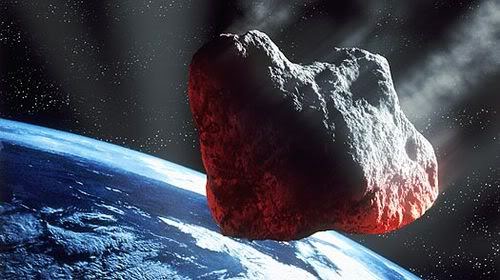In this new video from Big Think, astrophysicist Neil deGrasse Tyson says he’s almost embarrassed for our species that it takes a warning shot across our bow before legislators take seriously the advice they’ve been receiving from astronomers about getting serious about asteroid detection and deflection; that it’s a matter of when not if Earth will get smacked by an asteroid. “But it took an actual meteor over Russia exploding with 25 times the power of the atom bomb in Hiroshima to convince people that maybe we should start doing something about it.”
NASA’s KaBOOM Experimental Asteroid Radar Aims to Thwart Earth’s Kaboom

Over the past month, about a half dozen rather large asteroids have careened nearby our home planet and in one case caused significant injury and property damage with no forewarning – showcasing the hidden lurking dangers from lackluster attitudes towards Asteroid Detection & Planetary Defense.
Now in a prescient coincidence of timing, NASA is funding an experimental asteroid radar detection array called ‘KaBOOM’ that may one day help thwart Earth’s untimely Ka-boom – and which I inspected first-hand this past week at the Kennedy Space Center (KSC),following the SpaceX Falcon 9 blastoff for the ISS.
“KaBOOM takes evolutionary steps towards a revolutionary capability,” said Dr. Barry Geldzahler, KaBOOM Chief Scientist of NASA Headquarters, in an exclusive interview with Universe Today.
If successful, KaBOOM will serve as a prelude to a US National Radar Facility and help contribute to an eventual Near Earth Object (NEO) Planetary Defense System to avert Earth’s demise.
“It will enable us to reach the goal of tracking asteroids farther out than we can today.”
First some background – This weekend a space rock the size of a city block whizzed past Earth at a distance of just 2.5 times the distance to our Moon. The asteroid – dubbed 2013 ET – is noteworthy because it went completely undetected until a few days beforehand on March 3 and measures about 460 feet (140 meters) in diameter.
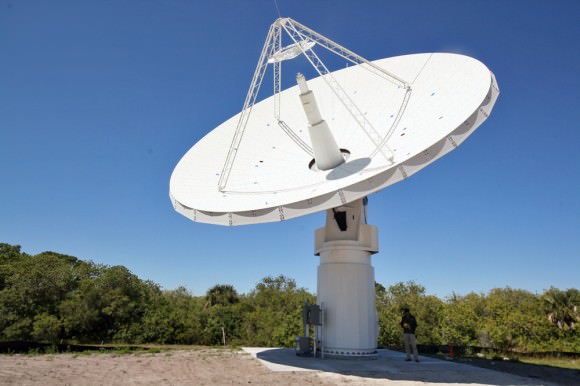
2013 ET follows close on the heels of the Feb. 15 Russian meteor that exploded violently with no prior warning and injured over 1200 people on the same day as Asteroid 2012 DA 14 zoomed past Earth barely 17,000 miles above the surface – scarcely a whisker astronomically speaking.
Had any of these chunky asteroids actually impacted cities or other populated areas, the death toll and devastation would have been absolutely catastrophic – potentially hundreds of billions of dollars !
Taken together, this rash of uncomfortably close asteroid flybys is a wake-up call for a significantly improved asteroid detection and early warning system. KaBOOM takes a key step along the path to those asteroid warning goals.
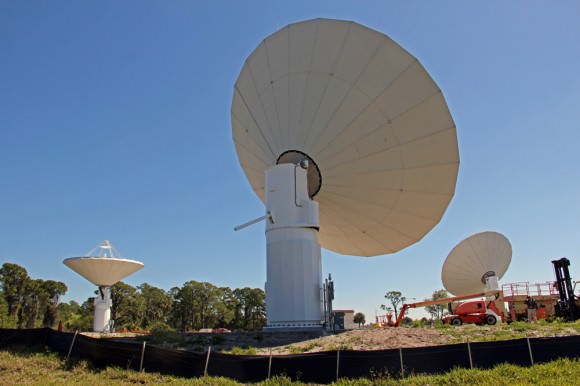
‘KaBOOM’ – the acronym stands for ‘Ka-Band Objects Observation and Monitoring Project’ – is a new test bed demonstration radar array aimed at developing the techniques required for tracking and characterizing Near Earth Objects (NEO’s) at much further distances and far higher resolution than currently available.
“The purpose of KaBOOM is to be a ‘proof of concept’ using coherent uplink arraying of three widely spaced antennas at a high frequency; Ka band- 30 GHz,” KaBOOM Chief Scientist Geldzahler told me.
Currently the KaBOOM array consists of a trio of 12 meter wide radar antennas spaced 60 meters apart – whose installation was just completed in late February at a remote site at KSC near an alligator infested swamp.
I visited the array just days after the reflectors were assembled and erected, with Michael Miller, KaBOOM project manager of the Kennedy Space Center. “Ka Band offers greater resolution with shorter wavelengths to image smaller space objects such as NEO’s and space debris.”
“The more you learn about the NEO’s the more you can react.”
“This is a small test bed demonstration to prove out the concept, first in X-band and then in Ka band,” Miller explained. “The experiment will run about two to three years.”
Miller showed how the dish antennae’s are movable and can be easily slewed to different directions as desired.
“The KaBOOM concept is similar to that of normal phased arrays, but in this case, instead of the antenna elements being separated by ~ 1 wavelength [1 cm], they are separated by ~ 6000 wavelengths. In addition, we want to correct for the atmospheric twinkling in real time,” Geldzahler told me.
Why are big antennae’s needed?
“The reason we are using large antennas is to send more powerful radar signals to track and characterize asteroids farther out than we can today. We want to determine their size, shape, spin and surface porosity; is it a loose agglomeration of pebbles? composed of solid iron? etc.”
Such physical characterization data would be absolutely invaluable in determining the forces required for implementing an asteroid deflection strategy in case the urgent need arises.
How does KaBOOM compare with and improve upon existing NEO radars in terms of distance and resolution?
“Currently at NASA¹s Goldstone 70 meter antenna in California, we can track an object that is about 0.1 AU away [1 astronomical unit is the average distance between the Earth and the sun, 93 million miles, so 0.1 AU is ~ 9 million miles]. We would like to track objects 0.5 AU or more away, perhaps 1 AU.”
“In addition, the resolution achievable with Goldstone is at best 400 cm in the direction along the line of sight to the object. At Ka band, we should be able to reduce that to 5 cm – that’s 80 times better !”
“In the end, we want a high power, high resolution radar system,” Geldzahler explained.
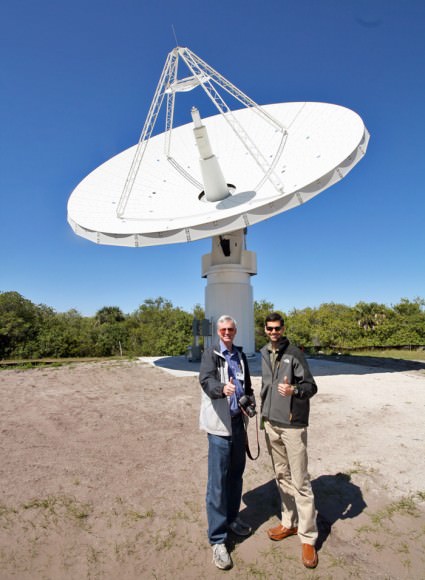
Ken Kremer; Universe Today and Mike Miller; NASA KSC KaBOOM project manager. Credit: Ken Kremer (kenkremer.com)
Another significant advantage compared to Goldstone, is that the Ka radar array would be dedicated 24/7 to tracking and characterizing NEO’s and orbital debris, explained Miller.
Goldstone is only available about 2 to 3% of the time since it’s heavily involved in numerous other applications including deep space planetary missions like Curiosity, Cassini, Deep Impact, Voyager, etc.
‘Time is precious’ at Goldstone – which communicates with some 100 spacecraft per day, says Miller.
“If/when the proof of concept is successful, then we can envision an array of many more elements that will enable us to reach the goal of tracking asteroids farther out than we can today,” Geldzahler elaborated.
A high power, high resolution radar system can determine the NEO orbits about 100,000 times more precisely than can be done optically.
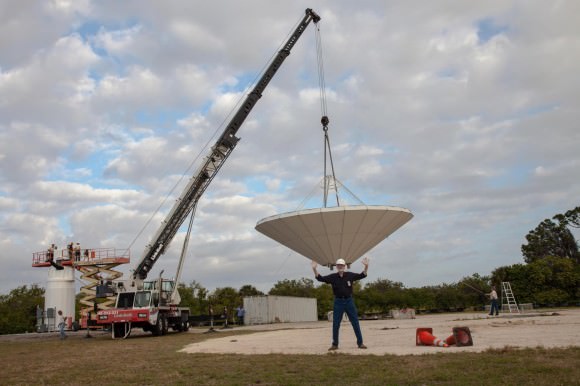
So – what are the implications for Planetary Defense ?
“If we can track asteroids that are up to 0.5 AU rather than 0.1 AU distant, we can track many more than we can track today.”
“This will give us a better chance of finding potentially hazardous asteroids.”
“If we were to find that a NEO might hit the Earth, NASA and others are exploring ways of mitigating the potential danger,” Geldzahler told me.
Kaboom’s ‘First light’ is on schedule for late March 2013.
More in Part 2
2014 AZ5: The Fake Asteroid that Won’t Hit Earth
Be careful where you get your news. Some websites have headlines that are screaming “GIANT ASTEROID HEADING TO EARTH!” or “2014 END OF THE WORLD!” It’s been billed as the largest threat to Earth in a millennium, and this supposed nearly 300 meter (1,000 ft.) -wide asteroid is spurring “urgent meetings going on among scientists on how deflect it.”
This asteroid can’t hit Earth because it doesn’t exist. Or at the very least, it doesn’t exist yet. The first clue this asteroid is a fake is its name: 2014 AZ5. Asteroids are named for the year they are discovered, and since it is only 2013…. well, you see the issue.
Additionally, this asteroid isn’t listed on JPL’s Small Body Database, or the Minor Planet Center’s website, the official places where all known asteroids are listed. As much as some people like to think there are conspiracies and government cover-ups, absolutely every asteroid that’s ever been detected is listed on these sites.
There is, actually, another asteroid that will be whizzing by Earth this week at a very safe distance of about 950,000 km. On March 9, Asteroid 2013 ET, a very large 100 meter-wide rock will make its closest approach. Gianluca Masi from the Virtual Telescope project will host a webcast from the Virtual Telescope robotic facility in Italy on March 8, 2013 at 19:00 UT (2 pm EST). You can watch for free on their website. “It is worth to underline that there are NO risks at all of collision,” Masi said.
Here’s an image of 2013 ET that Masi took on March 4, 2013:
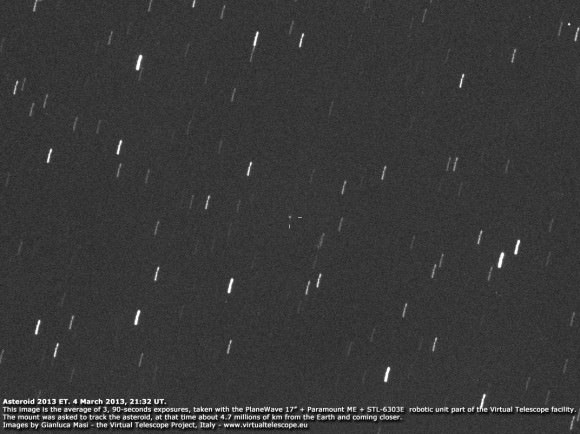
Hat tip: Ian Musgrave.
Newly Found Asteroid to Pass Within Moon’s Orbit on March 4, 2013
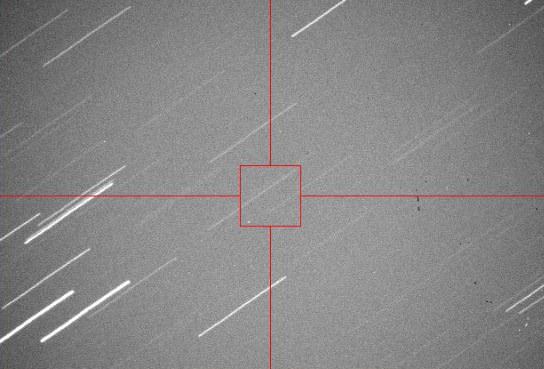
A newly found asteroid will pass just inside the orbit of the Moon, with its closest approach on March 4, 2013 at 07:35 UTC. Named 2013 EC, the asteroid is about the size of the space rock that exploded over Russia two and a half weeks ago, somewhere between 10-17 meters wide. The asteroid that sparked the Russian meteor is estimated to have been about 17 meters wide when it entered Earth’s atmosphere.
2013 EC was discovered by the Mt. Lemmon Observatory in Arizona on March 2. There is no chance this asteroid will hit Earth.
2013 EC will come within 396,000 kilometers from Earth, (246,000 miles, or around 1.0 lunar distances, 0.0026 AU.
The Moon’s distance from the Earth varies between 363,104 km (225,622 miles) at perigee (closest) and 406,696 km (252,088 miles) at apogee (most distant point).
Gianluca Masi from the Virtual Telescope Project had a live view of the asteroid when it was about twice the distance of the Moon, and a replay of that webcast is available below. (Views of the asteroid start at about 31:00 in the video.)
“That we are finding all these asteroids recently does not mean that we are being visited by more asteroids,” Masi said during the webcast, “just that our ability to detect them has gotten so much better. Our technology has improved a lot over the past decades.”
More info about 2013 EC on the JPL Small Body Database.
Satellite Swarm — Including an Asteroid Hunter — Readies For Spaceflight
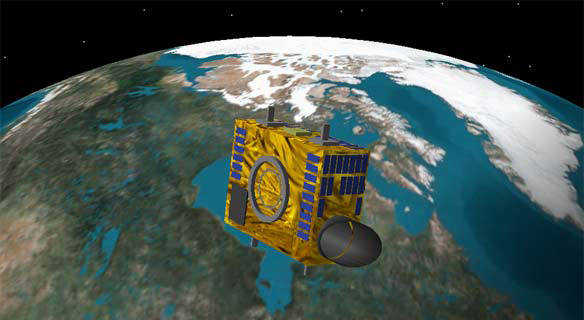
Early next week, an Indian rocket will launch into space carrying seven satellites on board. Among them will be a small but mighty asteroid-hunting telescope called NEOSSat. Built by the Canadian Space Agency, it will mainly focus on the Atira class of asteroids, which are made up of space rocks within Earth’s orbit, to figure out their size and distribution. The suitcase-sized NEOSSat will orbit approximately 800 kilometers above Earth, searching for near-Earth asteroids that are difficult to spot using ground-based telescopes.
Here’s a full rundown of what’s soaring to space on Monday (Feb. 25), if all goes to plan. Check out the launch from India at this link; it’s supposed to go into space around 7:25 a.m. Eastern (12:25 p.m. UTC).
– NEOSSat (Canada). Short for Near-Earth Object Surveillance Satellite, the satellite is actually split into two different missions. For half the time, it will be keeping a sharp eye out for asteroids that may swing by Earth at some point. The telescope will spend its other science mission watching satellites and space debris in orbit, to better track their movements.
“NEOSSat will discover many asteroids much faster than can be done from the ground alone,” said Alan Hildebrand of the University of Calgary. “Its most exciting result, however, will probably be discovering new targets for exploration by both manned and unmanned space missions.”
– SARAL (India/France). This is by far the largest satellite of the fleet; the rest of the mini sats listed below are hitching a ride to share launch costs. The satellite is supposed to take altimeter measurements of water and ice to watch the movement of waves and to add more data into climate change databases, among other objectives.
– CanX-3 BRITE (Canada). The BRIght Target Explorer is billed as the smallest astronomical telescope, at just 8 inches (20 centimeters) across. Unlike bigger observatories that focus on very faint objects, BRITE will — as the name suggests — watch over brighter stars that we commonly use on Earth to connect the dots in constellations. Oddly enough, despite their prominence in our sky, these brighter stars are poorly studied, astronomers said.
– Sapphire (Canada). A military mission, this satellite will keep track of objects orbiting between 3,800 and 25,000 miles (6,000 and 40,000 kilometers) from Earth. The Canadians will share this information with their close military ally, the Americans.
– TUGSat-1 BRITE (Austria). This will be the first Austrian satellite. Like CanX-3, it will investigate bright stars by watching the changes in brightness using a technique called photometry (measuring visible light.) The satellite is equipped with a high-resolution CCD imager to take pictures.
– AAUSat 3 (Denmark). This satellite will test the capabilities of automatic identification of ships (AIS) technology, following the beacons that ships are required to send out with information about their cargo and destination. Most of the testing will focus on the water around Greenland.
– STRaND-1 (United Kingdom). This satellite is literally a screamer, as it will be broadcasting the sound of human screams into space to see if anyone nearby can hear them. (This is to test the oft-repeated phrase that in space, nobody can hear you scream.) Besides monitoring shrieks, the satellite makers will be testing how well the satellite is controlled by a smartphone. The acronym is short for Surrey Training, Research and Nanosatellite Demonstrator.
Infographic: What’s the Difference Between a Comet, Asteroid and Meteor?
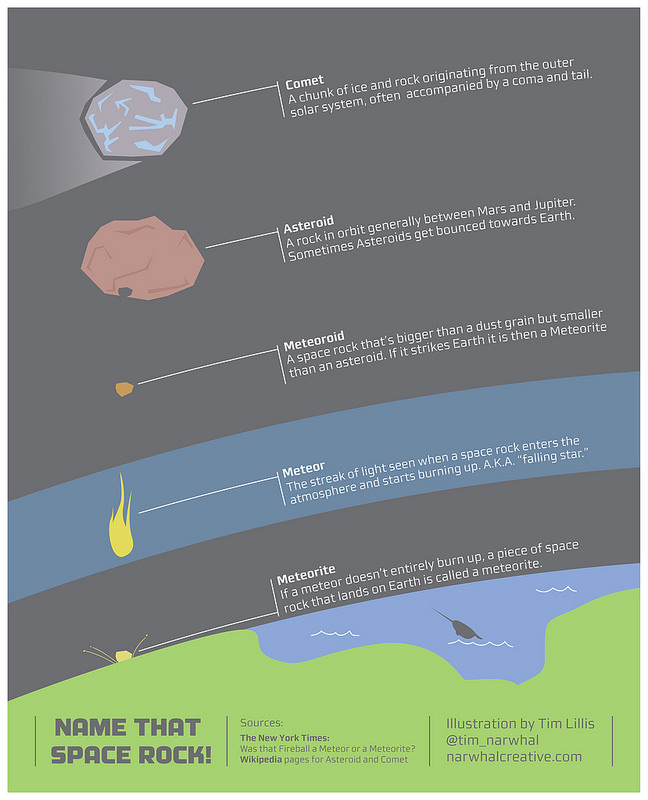
With all the various space rocks flying by and into Earth last Friday, perhaps you’ve been wondering about the correct terminology, since a rock from space has different names depending on what it is made of and where it is.
Infographics artist Tim Lillis has put together a primer of sorts, in the form of an infographic, describing the different between a comet, asteroid, meteoroid, meteor and meteorite.
Asteroids are generally larger chunks of rock that come from the asteroid belt located between the orbits of Mars and Jupiter. Sometimes their orbits get perturbed or altered and some asteroids end up coming closer to the Sun, and therefore closer to Earth.
Comets are much like asteroids, but might have a more ice, methane, ammonia, and other compounds that develop a fuzzy, cloud-like shell called a coma – as well as a tail — when it gets closer to the Sun. Comets are thought to originate from two different sources: Long-period comets (those which take more than 200 years to complete an orbit around the Sun) originate from the Oort Cloud. Short-period comets (those which take less than 200 years to complete an orbit around the Sun) originate from the Kuiper Belt.
Space debris smaller than an asteroid are called meteoroids. A meteoroid is a piece of interplanetary matter that is smaller than a kilometer and frequently only millimeters in size. Most meteoroids that enter the Earth’s atmosphere are so small that they vaporize completely and never reach the planet’s surface. And when they do enter Earth’s atmosphere, they gain a different name:
Meteors. Another name commonly used for a meteor is a shooting star. A meteor is the flash of light that we see in the night sky when a small chunk of interplanetary debris burns up as it passes through our atmosphere. “Meteor” refers to the flash of light caused by the debris, not the debris itself.
If any part of a meteoroid survives the fall through the atmosphere and lands on Earth, it is called a meteorite. Although the vast majority of meteorites are very small, their size can range from about a fraction of a gram (the size of a pebble) to 100 kilograms (220 lbs) or more (the size of a huge, life-destroying boulder).
Thanks again to Tim Lillis for sharing his infographic with Universe Today. For more info about Tim’s work, see his Behance page, Flickr site, Twitter, or his website.
First Radar Observations of Asteroid 2012 DA14
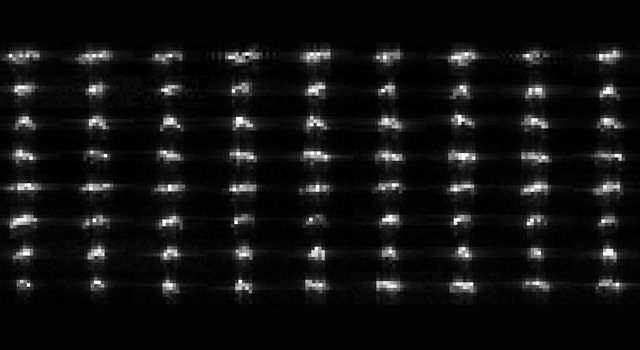
The Jet Propulsion Laboratory has released an initial view of radar observations of asteroid 2012 DA14 generated from data obtained by NASA’s Goldstone Solar System Radar, taken on Feb. 15-16, 2013 as the asteroid headed away from Earth. While these first radar data aren’t very picturesque, they do reveal one obvious thing: this asteroid is tumbler.
The movie is comprised of 73 radar “images” looped nine times. JPL said that during the observations, the space rock’s distance increased from 120,000 to 314,000 km (74,000 to 195,000 miles) from Earth. The resolution here is 4 meters per pixel.
The images span close to eight hours and clearly show an elongated object undergoing roughly one full rotation. JPL said the images suggest that the asteroid has a long axis of about 40 meters (130 feet). The radar observations were led by scientists Lance Benner and Marina Brozovic of JPL. Additional Goldstone radar observations were taken as the asteroid continued to move away from Earth, on February 18, 19, with more observations scheduled on the 20th.
Radar is one of the best techniques for studying an asteroid’s size, shape, rotation state, surface features and surface roughness, and for improving calculations of its orbit. Radar measurements of asteroid distances and velocities often enable computation of asteroid orbits much further into the future than if radar observations weren’t available.
Source: JPL
Photos and Videos of Asteroid 2012 DA14 ‘Running Fast Among the Stars’
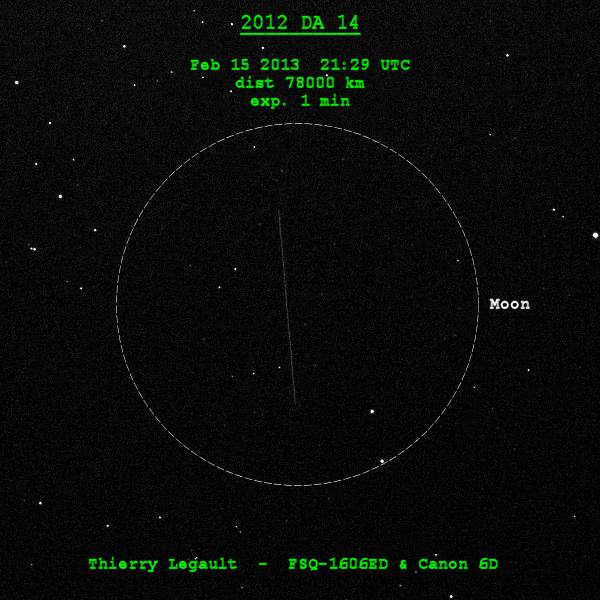
Yesterday a 50 meter (160 foot) rock passed just over 27,000 kilometers (17,000 miles) from the Earth’s surface. This big space rock, named 2012 DA14, dodged us while another smaller and unrelated asteroid gave us an extraterrestrial punch over Russia (read more about that here). Telescopes around the world — both big professional ones and smaller amateur ones — focused on the fast-moving 2012 DA14, whizzing along at 28,100 kilometers per hour (17,450 miles per hour), or 7.82 kilometers per second (4.8 miles per second) relative to Earth.
Here are some of the images from around the world of 2012 DA14. Noted French astrophotographer Thierry Legault sent Universe Today a note that he “easily spotted it visually through the 4″ refractor. It was running very fast amongst the stars!” he said.
In a really nice piece of astrophotography, François Colas from the Pic du Midi observatory in southern France captured the fast moving asteroid with just the right combination of exposure, allowing him to get the asteroid as a point and not a line. He used a Pentax K5 – 6400 ASA – 85mm f/1.4. Field of view 15°
Richard Fleet from Wiltshire, England also got a good capture of the asteroid. “Clouds were a problem most of the evening but I did manage to catch it going past the Coma Berenices cluster,” he said via email. “I saw the asteroid several times in 15×75 binoculars and the motion was obvious in seconds when it was near a star, though it took a bit longer to be sure in the more barren areas.”
He used a used a 200mm lens on a Canon 5D for the very nice sequence as it ‘ran among the stars’:

The Remanzacco Observatory team has been following 2012 DA14 for a few days (click on the image above for their animation if it not ‘animating’.) See their website for several different shots from various remote telescopes around the world.
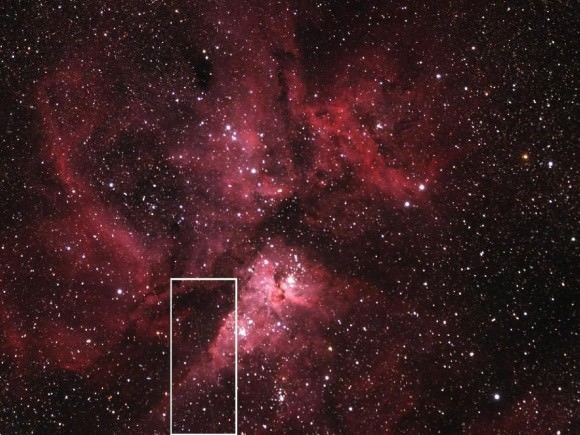
This image shows asteroid 2012 DA14 and the Eta Carinae Nebula, with the white box highlighting the asteroid’s path. The image was taken using a 3″ refractor equipped with a color CCD camera. The telescope is located at the Siding Spring Observatory in Australia and is maintained and owned by iTelescope.net. Credit: Aaron Kingery/NASA/MSFC
Gianluca Masi from the Virtual Telescope Project held a special webcast for the close approach of this asteroid. He reported they had more than 150,000 viewers from 166 countries. “Unfortunately, the clouds came, too, but at least we had some clear skies soon after the minimum distance was [reached],” he wrote. “For the occasion, the PlaneWave 17? robotic unit was used, trusting its exceptional Paramount ME robotic mount. The mount was controlled by TheSkyX Pro suite and the software was perfectly tuned to track this VERY DIFFICULT target. The results shown here speak by themselves: the asteroid was perfectly tracked, despite it was moving at 0.65 degrees per minute! All this after the scope was just slewed, without any manual adjustment! Amazing.”
2012 DA14 was about 36,500 km from Earth at the time.

The Talmassons astronomy club from Udine, Italy took this imagery:
Shahrin Ahmad from Kuala Lumpur, Malaysia posted some of his images on Google+:
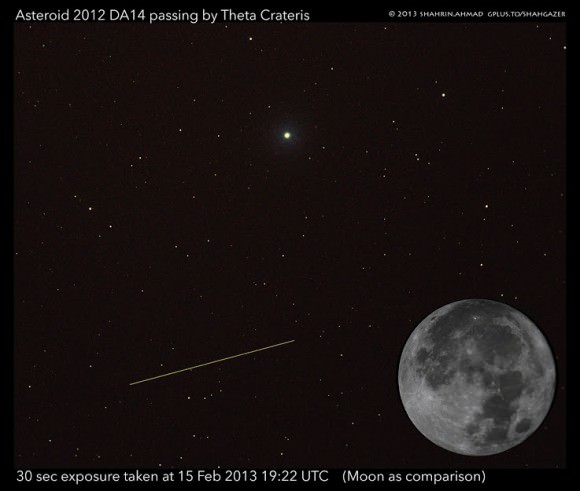
Nahum Mendez Chazarra from Spain’s Centro de Investigación y Divulgación Astronómica del Mediterráneo sent the video below. You can see more images on their Facebook page.
The Bareket Observatory in Israel had a live webcast of 2012 DA14’s close pass, and they reported they had more than 150K viewers overall. Here is a video they put together of some of the highlights of their observations:
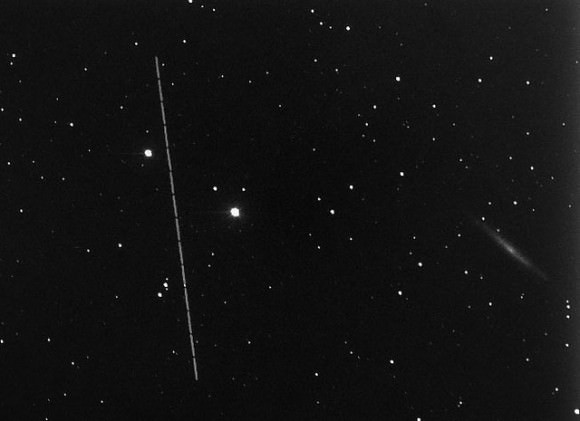
Nick Rose from San Mateo, California tracked 2012 DA14 on its way as it headed away from Earth, using a 6″ reflector with a high end Orion CCD imager on a modified Vixen Super Polaris mount, on the evening of February 15. “I inverted the image to make it easier to see the asteroid,” Nick said, “and the video consists of 100 10 second Binned 1×1 images.”
Mikko Suominen, a freelance science journalist from Finland created this 3-D animation based on the JPL’s information graphics using rendering software called Blender. “They ar not extremely precise,” Suominen said via email, “but for popular science purposes I think they are accurate enough.”
Want to get your astrophoto featured on Universe Today? Join our Flickr group or send us your images by email (this means you’re giving us permission to post them). Please explain what’s in the picture, when you took it, the equipment you used, etc.
Airburst Explained: NASA Addresses the Russian Meteor Explosion
A small asteroid entered Earth’s atmosphere early Friday, February 15, 2013 over Chelyabinsk, Russia at about 9:20 am local Russian time. Initial estimates, according to Bill Cooke, lead for the Meteoroid Environments Office at NASA’s Marshall Space Flight Center, is that the asteroid was about 15 meters (50 feet) in diameter, with a weight of 7,000 metric tons. It hit the atmosphere at a shallow angle of about 20 degrees, at a speed of about 65,000 km/h (40,000 mph).
It traveled through the atmosphere for about 30 seconds before breaking apart and producing violent airburst ‘explosion’ about 20-25 km (12-15 miles) above Earth’s surface, producing an energy shockwave equivalent to a 300 kilotons explosion. That energy propagated down through the atmosphere, stuck the city below – the Chelyabinsk region has a population of about 1 million — and windows were broken, walls collapsed and there were other reports of minor damage throughout the city.
The official impact time was 7:20:26 p.m. PST, or 10:20:26 p.m. EST on Feb. 14 (3:20:26 UTC on Feb. 15).
Cooke said that at this time, the known damage is not due to fragments of the bolide striking the ground but only from the airburst. “There are undoubtedly fragments on the ground, but at the current time no pieces have been recovered that we can verify with any certainty,” Cooke said during a media teleconference today.
He added that the space rock appears to be “an asteroid in nature,” – likely a rocky asteroid since it broke apart in the atmosphere. It wasn’t detected by telescopes searching for asteroids because of its small size, but also because “it came out of the daylight side of our planet – was in the daylight sky and as a result was not detected by any earth based telescopes. #RussianMeteor was not detected from Earth because it came from the daylight side (i.e the Sun-facing side of Earth).
The meteor left a trail in the sky about 480 km (300 miles) long.
Cooke, along with Paul Chodas, a research scientist in the Near Earth Object Program Office at NASA’s Jet Propulsion Laboratory said that asteroids this size hit the Earth on average about once every 100 years. “These are rare events, and it was an incredible coincidence that it happened on the same day as the close flyby of Asteroid 2012 DA14,” Chodas said. “The two are not related in any way.”
The Russian meteor is the largest reported since 1908, when a meteor hit Tunguska, Siberia. Oddly enough, the Tunguska event was caused by an object about the size of 2012 DA14, the asteroid that flew by Earth today harmlessly. The meteor, which was about one-third the diameter of asteroid 2012 DA14, became brighter than the Sun, as seen in some of the videos here. Its trail was visible for about 30 seconds, so it was a grazing impact through the atmosphere.
There were certainly pieces that hit the ground, according to Jon M. Friedrich from Fordham University. “For something that created a bolide and sonic detonation of the size seen in Russia, it seems likely that fragments reached the earth,”Friedrich said in an email to Universe Today. “In fact, there are reports of a crater in a frozen lake and other locations that were in the path of the meteor. The resulting fragments are not likely large – I’d expect some of the absolute largest to be football to basketball sized, with many fragments being smaller, like marbles.”
Chodas said that defending the Earth against tiny asteroids like this is challenging issue, “something that is not currently our goal,” he said. “NASA’s goal it to find the larger asteroids. Even 2012 DA14 is on the smaller size. The tiny asteroid that hit over Russia is very difficult to detect, an in order to defend the Earth, the problem and issue there is to find these things early enough to do something about it if we wanted to divert it. While smaller asteroids are easier to divert, they are much more difficult to detect.”
“What an amazing day for near Earth objects,” Chodas said, “with two events happening on the same day.”
The lead animation courtesy of Analytical Graphics, Inc.
Weekly Space Hangout, Feb. 15, 2013: Space Rocks Edition
We interrupt your regular Weekly Space Hangout with this extra special edition to cover to the two asteroid-related events: the Russian meteor explosion and the close pass of Asteroid 2012 DA14.
Joining us for the space round table:
Dr. Ian O’Neill, Dr. Pamela Gay, Dr. Thad Szabo, Dr. Nicole Gugliucci, Nancy Atkinson, and Scott Lewis
Host: Fraser Cain
We record the Weekly Space Hangout every Friday at 12 pm Pacific / 3 pm Eastern. You can watch us live on Google+, Cosmoquest or listen after as part of the Astronomy Cast podcast feed (audio only).

